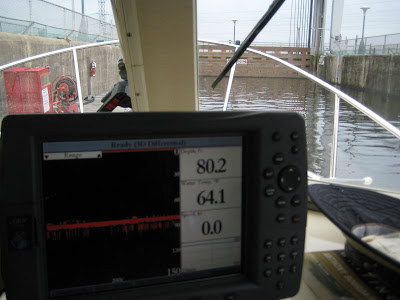

Pecan left Hawkesbury at 7:54am with cloudy and warm, 20 deg C, conditions. Winds 5 knots out of the SW. Water temperature 63 deg F. We timed our lea6ving to get to the Carillon locksite at their opening time of 9:30am. We arrived at 9:23am. This lock is notable because it is a whooping 65 foot water level drop and they employ a unique guillotine-style lock door on the downstream end. Check out the video of the door opening.
Next lock on the Ottawa was the St. Anne de Bellevue lock. By now it was raining but we had an uneventful lockthru. After this lock we entered the Lac Saint Louis and the St. Lawrence river.
We headed over the a small western hamlet of Montreal called Lachine so we could position ourselves for a transit of the Lachine canal. This canal was instrumental for Montreal to develop as a center of commerce during the earliest days because the rapids in the St. Lawrence (aptly named Lachine Rapids) were very dangerous and impeded navigation upstream towards the Great Lakes. At any rate, our navigating the Lachine canal required that Pecan to no higher than 8 feet 0 inches off the water. A Lachine canal/lock operator came down to the boat with a specially calibrated pole to measure Pecan. We cleared by just a couple of inches! Thank goodness we had fuel and water tanks 90% full.

We're a bit early--arriving at 9:23am and they start the first lock thru at 9:30am. Here we're tied to the western blue line wall awaiting instructions.

A view of the lock doors from the blue line wall.

On busy days during the season, Canada Parks Service has this nifty diagram showing the order or arrangement they want boaters to tie up to establish lock-thru priority. Today--virtually the end of the season--we are the only ones going thru.

This lock serves an additional major advantage--it's an integral part of Hydro-Quebec's Carillon generating plant, producing 752 megawatts of electricity.

Depthsounder showing depth of 80.2 feet before we begin the descent.

One very nice feature of this lock--unlike all before--is the floating dock we tie up to *inside* the lock. No fussing with lines this time, and I can walk around as we descend.


From the Parks Canada brochure: "The Carillon Canal, inaugurated in 1834, provided a route around the rapids on the Ottawa River. Originally consructed for military reasons, the canal served commercial transport from the beginning. Completed in 1833, the first Carillon Canal would, with the Chute-a-Blondeau and the Grenville Canals, make it possible to clear a series of rapids covering 20 kms, called Long Sault. Adjacent to the hydroelectric dam, the impressive lock is more than 20 m high and today, boats can navigate the sharp drop in only 30 minutes. The same trip in the original canal system involved three canals and eleven locks.

Depthsounder showing we descended 58.7 feet.
Our descent complete, here's a video of the Carillion 'guillotine' lock dock opening upwards.

Goodbye Carillon lock.

As the drizzly rain sets in, we've entered the last set of locks in the Ottawa River--Sainte-Anne-de-Bellevue lock. Tamara is out on the floating dock talking with our Parks Canada lock operator.
From the Parks Canada brochure: The Sainte-Anne-de-Bellevue Canal is located at the mouth of the Ottawa River. It links Lac Saint-Louis and Lac des Deux-Montagnes. It is located on a well-known waterway in Quebec and is the busiest historic canal in the province. The canal was used for commercial shipping from the time of its inauguration in 1843, and it quickly became part of the Montreal-Ottawa-Kingston navigation triangle. The Sainte-Anne-de-Bellevue Canal played an important role in the inland movement of immigrants and of lumber shipping. Today, the Sainte-Anne-de-Bellevue lock is used primarily by pleasure craft. With many terraces near the site, it has a unique urban feel.

By mid-afternoon we've reached the Lachine canal entrance. After tying up at the blue line floating dock, we walked to the Lachine canal authority office (and museum) to request/schedule our lock-thru for the following day. Also, we had to get Pecan's height off the water, or air draft, measured to make sure we would clear their lowest fixed bridges--8 feet! Here's the lock operator measuring Pecan with their customized pole. As you can see, we just make it.

About a week or so ago, when we were looking at deciding how to proceed towards Montreal, I heard and read about the 8 foot maximum air draft necessary to do the Lachine canal. (Vessels with higher air drafts must proceed thru the big ship locks in the St. Lawrence river.) But, I wondered, how hard and fast was this "8 foot". Was that plus or minus six inches? 1 foot? Well, we soon found out and I confirmed--with a handy measuring tape--that indeed the maximum air draft is 8 feet 0 inches.

This late in September, the Lachine canal operates under reduced lock thrus in the fall.



No comments:
Post a Comment